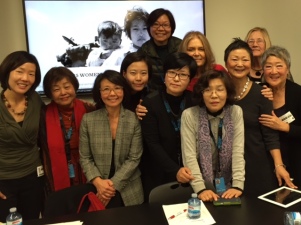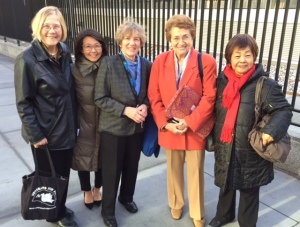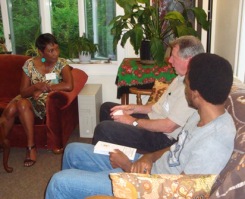The Occupy Wall Street movement spreading across the country reminds us of other movements when ordinary people—like the “diverse bunch” who organized to create a non-violent focus for positive change—embarked on the Great Peace March for Global Nuclear Disarmament from California to Washington, DC. In 1986, the Peace Development Fund supported the marchers who, despite loose organization and trying circumstances, stood up to say “enough” to war and make their voices heard. The Great Peace March  nearly fell apart as it moved from the west coast eastward, and there are certainly a few lessons to learn from this by Occupy Wall Street. But like Occupy Wall Street, the Great Peace March gathered momentum. Now Occupy Wall Street is changing the terms of the public debate, from despair that the financial world is stacked against Main Street to active concern about local jobs, education and the environment. Just as the Great Peace March entered people’s collective consciousness as they marched forward, Occupy Wall Street has the potential to mobilize thousands demanding jobs for all and civil rights. Perhaps it’s time for another great march.
nearly fell apart as it moved from the west coast eastward, and there are certainly a few lessons to learn from this by Occupy Wall Street. But like Occupy Wall Street, the Great Peace March gathered momentum. Now Occupy Wall Street is changing the terms of the public debate, from despair that the financial world is stacked against Main Street to active concern about local jobs, education and the environment. Just as the Great Peace March entered people’s collective consciousness as they marched forward, Occupy Wall Street has the potential to mobilize thousands demanding jobs for all and civil rights. Perhaps it’s time for another great march.
from Peace Developments, Fall 1986
“The Great Peace March”
“Sure, we’re a diverse bunch,” says Larry Heiss, camp doctor for the Great Peace March. “We’ve got kids and septuagenarians, professional people and counter-culture youth, straight and gay, the angry and the serene, the ministers and agnostics, politically left and politically right, people form 50 states and eleven countries. But we’ve got one important thing in common: we are all committed to global nuclear disarmament.
As one of the core group that has been on the 3,200-mile peace walk across the U.S.A. since its start, Larry has seen the whole panorama: from the shaky send-off in Los Angeles on the first of March, through the breakdown of the original ProPeace organization two weeks later, leaving 1,200 walkers stranded on the edge of the Mojave Desert; through a determined but wrenching struggled to reorganized, raise money, and keep going; across deserts and mountains and plains to Omaha at an incredible 20 to 25 miles a day in order to catch up to the original schedule.
Together they’ve walked, despite blisters and sunburn, through desert sizzle and mountain frost, through hail and thunderstorms, through the fallout area downwind of the Nevada Nuclear test Site at the time of the Mighty Oaks test, past some of the nuclear facilities and military installations that bristle across our West. There was a high moment of celebration as they crossed the Continental Divide, with jokes that from now on it would “all be downhill.”
The marchers had faced staggering problems in their forming their new organization. All their equipment, including support vehicles, had been repossessed. They wouldn’t be allowed to march without at least portable toilets (which the Peace Development Fund was instrumental in getting for them). Everything has to be started again from scratch, and by a group with no experience.
But there were people like a man and his daughter from Sydney, Australia, who had raised money in their community in order to get to Los Angeles and join the march. As Phyllis Rodin, another marcher, said, “no way could we tell people like that ‘It’s folded. It’s over. Go home.’”
“We were halted in our tracks for three weeks in Barstow, California,” related Phyllis. “But it was an important three weeks. We moved from a green, helpless group of strangers, into a cohesive, fired-up determined community.”
In order to get the march back on the road, the marchers began to scavenge and resuscitate ancient junkyard trucks. Soldiers (in civilian clothes) from nearby military bases turned up to help with that thankless job. In gratitude for the outpouring of help from Barstow, the marchers painted the town’s church inferiors.
A newly-formed advance team had to start contacting peace groups and town officials in the areas ahead, to arrange for camp sites, permits, water, waste disposal, peace rallies, and speaking engagements. It helped when town officials learned that the marchers were cleaning up the roadsides as they walked.
Omaha seemed like a turning point. There, they were back on schedule and could slow their pace to a mere 15 miles a day. There they were halfway to their final goal, Washington, DC.
“We don’t feel we’ll be stranded again,” Larry says with confidence in spite or reporting that their income at present is less than their outgo.” We know now that nothing can stop us from getting to Washington. We know the support is out there, and we’re confident the money will come in when people realize we need it.”
Expenses are $7 a day per marcher – $4,000 a day total – for food, insurance, payments on the support vehicles, campsite permits, publicity, gas. The high cost of marching has sometimes meant turning down people who would like to join in. In spite of that, the number had grown from 500 to 650 by Omaha, with hopes that as the new fundraising canvas bring in additional support, the group can also expand. By the time the group gets to New York City, in mid-October, the march almost certainly will be considerably larger. And optimism runs high when they talk about arriving in Washington, DC for a mid-November final rally.
 Within the march there are, of course, differences of opinion. “Peace begins with ourselves,” as Larry Heiss says, “and it’s not always an easy lesson.”
Within the march there are, of course, differences of opinion. “Peace begins with ourselves,” as Larry Heiss says, “and it’s not always an easy lesson.”
But despite the occasional friction, there’s a lot of camaraderie, creativity, energy, and humor. Musicians, comics, and clowns have teamed up within the marching community to keep spirits high.
There is also support, both moral and financial, from “outside.” The marchers are visited by national celebrities, such as Pete Seeger, Holly Near, Hill Street’s Betty Thomas, and Congresswoman Pat Schroeder of Colorado. There are rallies and house parties, and marchers-for-a-day who join them in every city.
It’s an adventure for everyone, perhaps especially for the 40 children on the march, some of whom have become experienced speakers already. From one-year-old Alexa to 8-year-old Franklin Folsom, everyone counts.
“Something is very different about this march,” to quote marcher Tom Atlee. “I don’t’ know why so many cars honk and give us a peace sign; why so many mothers cry as we pass; why fundamentalist veterans stop by the road to bless us; why old women with American flags hanging over their doors thank us for marching for them. Maybe it’s because 95 percent of Americans really want peace, and that desire is beginning to ache inside. If they had a way to be peaceful AND patriotic AND honestly hopeful, they’d grab it in an instant …
“Hope grows here like moss on a pine. I can’t shake the feeling that I’m witnessing a metaphorical dawn; that the darkness is giving way; that in the next year, perhaps in the next few months or days, I will see the edge of the sun and know that we, as a planet, have made it.”












